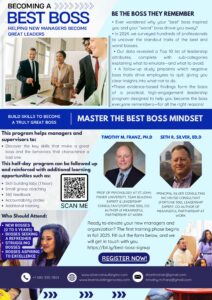Outline of ‘Becoming a Best Boss’
A Half-Day Leadership Program
(Developed by Seth R. Silver, Ed.D. & Timothy M. Franz, Ph.D.)
Note: Ideal for Newer Leaders (0-10 yrs in management)
Introduction: Looking back on our careers, most of us can easily recall the “best” boss we have ever had as well as the “worst” boss. These two individuals stand out prominently in our memory for their starkly different attitudes, behaviors and characteristics. We are confident that they had very different impacts on us and our colleagues. In 2024, we asked hundreds of people, of diverse backgrounds, experience, and organizations, to describe the attributes of their best and worst bosses. The descriptions were heartfelt, rich in detail, and insightful. The clear themes that emerged were also consistent and compelling. Based on the data, we have a Top 10 List of what “best bosses” do, and conversely what “worst bosses” do. We have also developed helpful sub-categories to explain each of the of the 10 attributes. We now also have data from a second study that confirms specifically which of the worst boss attributes are most likely to cause an employee to quit. These research findings form the foundation of a high impact, high engagement leadership development program. In short, this is an evidence-based yet practical session on how to become a best boss, avoid being a worst boss, and lead your team in ways that will make you memorable for all the right reasons!
Program Description: This half-day, highly interactive session begins with a powerful reflection and discussion about participant experiences with their own best and worst boss, and how these experiences affected them. The session then provides a fascinating overview of the key findings from our research. Participants then conduct a self-assessment, rating themselves on the Top 10 lists, and determine potential areas of strength and areas where they can develop and improve. In small groups, participants share their ratings, discuss ways to become better, and commit to initial key changes. The program then goes into more detail on the top 5 best boss attributes, providing practical ideas on each one. In pairs, participants then share their experience and best practices on these, and develop action plans related to their leadership. Last, there is a short review and discussion of the top 5 worst boss attributes and their impacts on employees/organizations. By the end, participants will understand why being a best boss matters, know what constitutes a best boss in our current workplace and how they fit that ideal, know how to practice the main attributes/behaviors of a best boss, and commit to making a positive difference for their teams.
Learning Outcomes:
Participants in this half-day workshop on Becoming a Best Boss will:
- Reflect on their experiences with best and worst bosses
- Learn the results of recent best/worst boss research and the implications for becoming an exceptional leader
- Conduct a self-assessment on their attributes as a boss
- Learn practical ways to improve through self-reflection, peer discussion and evidence
- Finally, learn what NOT to do, so as to avoid behaviors/characteristics that will damage your staff and organization
Seth R. Silver, Ed.D., Organizational Consultant and Author
Dr. Silver is the principal of Silver Consulting, Inc., an independent consulting practice, where he has worked with hundreds of client organizations in health care, higher education, high tech, government, business services, manufacturing and non-profit. His consulting focuses on two key areas: developing and improving leadership; and creating high engagement, high performance workplaces. He provides such services as executive coaching, leadership training, team development, conflict resolution, building effective workplace partnerships, strategic planning, and organizational/team diagnosis.
Dr. Silver has developed a unique business process called the Workplace Covenant, which helps parties in any organization to exchange and agree upon reciprocal obligations and expectations so as to ensure trust, feedback and alignment in their relationship. In 2021, he co-authored a book, entitled Meaningful Partnership at Work: How The Workplace Covenant Ensures Mutual Accountability and Success Between Leaders and Teams, to bring the concept to a wider audience.
From 2000 to 2014, Dr. Silver was a part-time Assistant Professor and taught Masters level students in Human Resource Development, teaching first at St. John Fisher University, and then at the Rochester Institute of Technology.
Dr. Silver holds a Bachelors degree from the University of Toronto, a Masters degree from Cornell University, and a Doctorate degree (Ed.D.) from The George Washington University. He has served on the Board of Directors for several non-profit organizations in the Rochester area, and is a citizen of both the US and Canada. More information about him and his work can be found at: SilverConsultingInc.com
Timothy M. Franz, Ph.D., Professor, Consultant and Author
Tim Franz is an Industrial and Organizational Psychologist at St. John Fisher University. He is a Professor and former Chair of the Department of Psychology and past graduate Program Director of the graduate Human Resource Development program. He works as an organizational consultant through his consulting organization, Franz Consulting and GLI.
Prior to his work as a professor, Dr. Franz worked full time as a human resources consultant. He earned his Ph.D. in Social/Organizational Psychology from the University of Illinois at Chicago, his M.A. from the University of Buffalo, and his B.A. from SUNY Oneonta.
His areas of expertise include applied research in organizations, individual and team decision making, improving team performance, improving team leadership, and using teams to drive organizational change. Many of his ideas about improving teams are published in his four books, titled Meaningful Partnership at Work: How The Workplace Covenant Ensures Mutual Accountability and Success between Leaders and Teams (August, 2021), Making Team Projects Work: A Resource for High School and College Educators, Making Team Projects Work: A Resource for High School and College Students (September, 2021) and Group Dynamics and Team Interventions: Understanding and Improving Team Performance (2nd edition in 2022). More information about his work can be found at TeamBuildingProcess.com.

